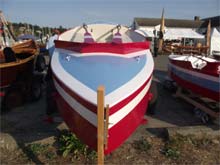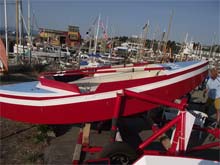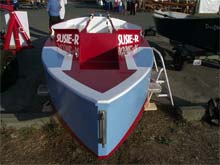
 Custom Search
|
|
| sails |
| plans |
| epoxy |
| rope/line |
| hardware |
| canoe/Kayak |
| sailmaking |
| materials |
| models |
| media |
| tools |
| gear |
| join |
| home |
| indexes |
| classifieds |
| calendar |
| archives |
| about |
| links |
| Join Duckworks Get free newsletter Comment on articles CLICK HERE |
|
|
| CHASING GHOSTS IN GRAND CANYON |
| A COLORADO RIVER RUN Prologue: The Magic of Rivers Name a river and you name an adventure, a journey into the heart of whatever lies waiting just ahead, around the next bend. A trip down a river is an entry into another kind of world, a sly meandering timeless world that hides the best of itself from the land it runs through and the people living along its banks. That is the magic of rivers, the source of their enduring appeal. For anyone with a boat and a set of oars or paddles, even the humblest local streams run strongly enough to pull us well out of reach of calendars and schedules, if only for an afternoon: Paint Creek. The Little Wolf. The Rat. The Fox. The Kickapoo. But there are rivers, and then there are rivers. And in the West, no river has a greater claim on our dreams than the Colorado. Threading its way through the endless canyons and buttes and spires of the Southwest, the Colorado is an icon or an archetype as much as it is a river. Since John Wesley Powell’s 1869 expedition (and even before then), a trip down the Colorado has been a siren song, and the country it traverses has become a symbol of a wildness as rare as it is valuable, a litany of what might have been, and a record of what yet remains. Glen Canyon. The Gates of Lodore. Cataract Canyon. Grand Canyon. But the stretches still undammed are places you can’t see, can’t really know, until you’ve run the river and looked up at the towering walls from a boat, scrambled up side canyons and walked along narrow beaches, rather than just looking down on glimpses of the river from a distant parking lot. To see the river and the canyon country it passes through on their own terms as much as possible—that, for me, is the lure of the Colorado. But I’ve never run real whitewater, never invested the time and gear to learn the language of rivers like this, rivers which, in their rushing descent through millions of years of geology have carved spectacular rifts and canyons—canyons which squeeze the water into narrow fast-moving chutes and rapids. Big rapids, some of them. *** I met Dave Mortenson at the Port Townsend Wooden Boat Festival in September of 2011. He was sitting in the shade of a couple of odd-looking garishly painted little red-white-and-blue rowboats, fully decked double-enders with flat bottoms and little rocker. They were loaded on two trailers, side by side, with Dave in a folding chair between them. I walked by him a few times, actually, glancing at the boats without saying anything. Bigger fish to fry. Gaff schooners. Oughtred yawls. Elegant faerings and sprit-rigged longboats. John Welsford and his SCAMP. Finally, though, I took a closer look, curious about what they were. Expedition rowboats? With their large sealed chambers, you’d have good flotation and room to store plenty of gear. They seemed heavily built for that, but I couldn’t come up with anything more likely. Turns out, though, that they were whitewater boats, replicas of historical designs created in the 1950s by Grand Canyon river runner Pat Reilly.
I spent a while talking to Dave Mortenson. His father had been on some of those 1950s trips, and Dave himself had run the Colorado through Grand Canyon in the early 60s, when the river was still wild—the days before Glen Canyon Dam. That early exposure had quite an impact, apparently; Dave Mortenson has been exploring Grand Canyon ever since, pioneering new hiking routes and running the river’s rapids. He was actually at Port Townsend to show the documentary he’d filmed about a 2011 run through Grand Canyon in the replica boats, he told me. And so by stopping to ask Dave Mortenson about his boats, I had stumbled across a small and interconnected world of Grand Canyon explorers and river rats. Fascinating stuff. And even better, a few months later, Dave invited me to run Grand Canyon with him in the spring of 2012, accompanying a group of five historic replicas and five modern rafts. If I was willing to row one of the rafts, there’d be room for me. “The hardest rapids don’t come until the end of the trip,” he told me. Apparently by then I’m supposed to know what I’m doing. ****** |





